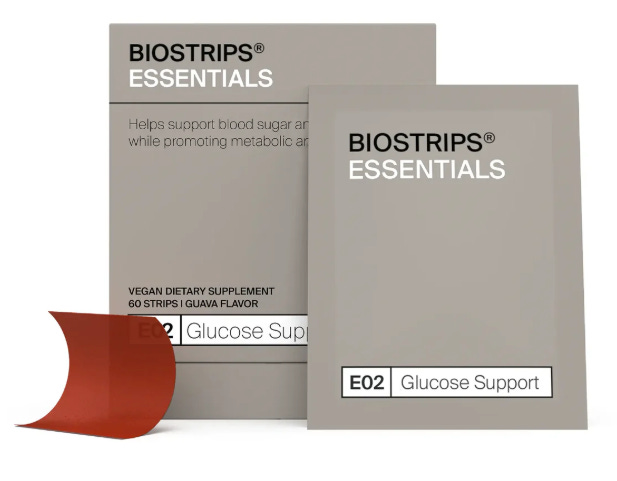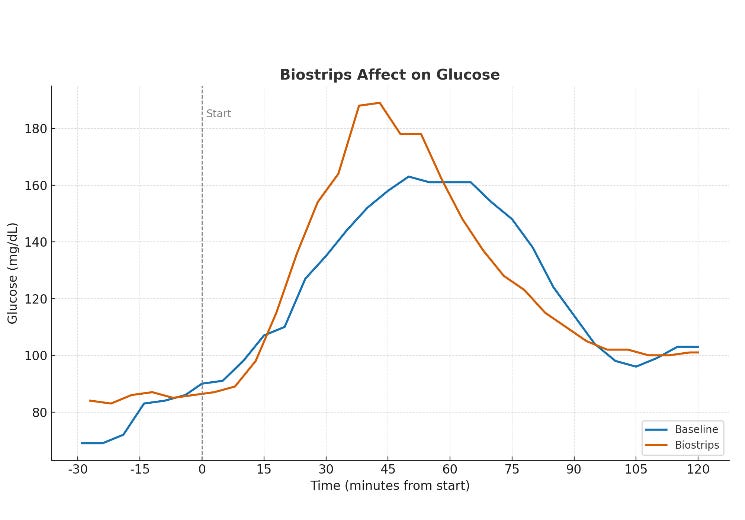Personal Science Week - 250807 Biostrips
Testing a new way to lower glucose
New products claim to help with the large blood glucose surges that can happen when you eat carb-heavy food. I’ve tested them in the past, but now a new company has an especially easy-to-take version.
This week I tried it, and while your results will almost certainly be different from mine, everyone can benefit from the powerful AI tools that made my analysis easy.
About Biostrips
Biostrips Essentials, are “sugar-free, fast-dissolving supplements designed to support balanced blood sugar and healthy metabolism in one convenient strip taken by mouth.”
The postage stamp-sized lozenges are more convenient than a pill or powder. Just slip them under your tongue and they’re gone in a couple of seconds. I wish more supplements were available this way.
The active ingredient is Reducose®, a proven glucose-lowering substance based on a mulberry leaf extract. I’ve tried various forms of Reducose in the past and found them effective. (See PSWeek 230615). The Biostrips also contain Chromax® (Chromium picolinate), another ingredient that supposedly affects insulin sensitivity.
They’re pretty expensive: $60 for a pack of 30. If you buy in bulk, the price is under $1.50/each, but that would be several dollars a day if you took them at every meal. My guess is that most people would reserve them for special occasions—when you want to eat some birthday cake, for example.
But metabolic diseases like diabetes will cost you a lot more than that, so this is a bargain if they really work.
Testing
I did the ultimate glucose tolerance test. On two separate days, after having fasted 8+ hours, I drank a glass of water mixed with 50g of pure glucose.
On one of the days (“Baseline”) I just drank the glucose water. On the other day I first took two of the Biostrips, letting them dissolve under my tongue right before consuming the drink.
Here’s what my CGM says were my glucose levels for the first two hours of each test:
In other words, there wasn’t much affect. The bigger spike from the Biostrips is probably noise.
IMPORTANT: this wasn’t a rigorous test. It’s possible that I could do the same experiment again and get different results—that’s the nature of personal experiments. Maybe I was extra tired on one of the days. Maybe I had a different circadian rhythm. Maybe I’d find an effect if I tested a dozen more times under more carefully controlled circumstances. Who knows?
In other words, don’t throw out your Biostrips or give up on the idea just because of my one stupid little experiment.
But in my experience, if something really works, it works. Life is messy. No two experiments are ever conducted under exactly the same circumstances, but your life isn’t conducted under carefully controlled circumstances either.
A Word About Methods
I tested myself while wearing a Freestyle Libre 3 CGM, like most of my years’ worth of glucose testing. It’s pretty easy to download Freestyle data as a CSV file, and normally I would use some basic Python or R scripts to do the analysis, but of course these days I just use ChatGPT.
It’s hard to describe how much more convenient it is to use an all-purpose LLM like ChatGPT for personal experiments. Although I’m not terrible at programming, I’m not the most organized guy on earth and honestly it would have taken me several hours to pull together my old scripts and get them working again. That’s not to mention the dozens, maybe hundreds of hours it took me to get up to speed on how CGMs work, learn the data format, and through trial-and-error figure out ways to study and present the results.
Now I just ask ChatGPT. I already knew how to download the CSV, but even if I didn’t, the LLM would have eagerly explained the process.
Yes, it’s possible that ChatGPT made a mistake (just like I might make a mistake if I did it manually). That said, I eyeballed the results with a quick glance at the data that was collected. Unlike early versions of LLMs, ChatGPT 4o now constructs its own Python script for the analysis, and you can view the source code or run it yourself; I didn’t go that far, but I’m pretty sure it’s unnecessary. If this were a professional situation where I was being paid to have the right answer, then I’d bother with the extra verification work, but these systems are progressing enough that soon I think we’ll be able to trust the results as well as we trust a human.
Try it Yourself
Don’t take my word for it. Get your own glucose experiment kits from Tastermonial. Their app makes it easy to try a specific product and do a rigorous test to see how your body responds. They’ve partnered with more than a dozen brands who offer big discounts for testing their products. Order your own pack of Biostrips for $30.
I’m doing a bunch more Tastermonial tests which I hope to write up over the next few weeks. (Incidentally, I have no financial or other relationship with Tastermonial other than as a fan of their interest in personal science.)
The Real AI Effect
By making it so easy to do the analysis and research, AI increases the importance of which questions to ask in the first place. My Biostrips analysis took less time than the experiment itself (which required a total of 4 hours over two days).
What does it mean when you can get detailed answers to any question, with references, at any time? I’m struggling to fully-appreciate the wonder of this, and to figure out the consequences for the future. What do you do when you have an eager PhD-level assistant at your beck and call? I’m finding myself asking dozens of questions a day, about books I’ve been reading (and thinking of reading), nutrition and medical questions, many technical topics, trip plans, etc. etc.
A huge part of personal science is understanding the context of a problem: how does it compare to other people? what’s the historical trend? what other similar issues I should consider?
For example, I recently read a newspaper article that mentioned the high ratio of unmarried men compared to women in Seattle (120) and I wondered how that compares to other cities. A few seconds later I had a table with specific references showing NYC (100), Los Angeles (130), Washington DC (85) and dozens of other cities. This is a question that I would have never bothered asking before LLMs.
Now that these AI tools make it so easy to find answers, I’m trying to open my mind to ask more questions.
Personal Science Weekly Readings
Speaking of another set of experiments I’d like to try, Hormometer from Eli Health is now available in beta. For about $400/year for 4x/month tests you get an iPhone-based saliva cortisol test. Since these diagnostics usually require a blood sample and lab visit, this makes it way easier to check cortisol levels at home to see how your body responds at different times of the day or under varying stress conditions. The company is also planning to release a similar test for progesterone, which can be important for women tracking their fertility.
And I recently learned about UltraHuman, a new $499 test of 100+ biomarkers, similar to Function Health (which I reviewed in PSWeek240912). Their twist is they tie it to one of their devices, like the $350 Ring AIR, to supposedly get more insight into your overall metabolism.
Our friend Jon Cousins has another cool comparison app that can help you figure out which book to read next. Recommendance is a short quiz that ends by giving you a sequence of numbers. Enter those numbers back into the app and see a long list of recommendations. (Try it with my numbers: 42 32 45 63 and see if your reading style resembles mine).
About Personal Science
By bringing professional-grade research assistance to everyone, AI tools open a golden age for personal scientists who have enough curiosity and imagination to apply this power to everyday life.
If you enjoy these weekly summaries, or have other topics you’d like to discuss, please let us know.





Nice article, Richard. Especially the detailed workflow and method around the testing of the strips. When I look at glucose curves, I focus less on the peak value (spike) and focus more on the decay slope (reflects capacity to distribute glucose out of circulation) and the area under the curve (reflects net glucose exposure). For me, the peak value is not so relevant unless you see a very large but short spike. This could drive glycosilation of circulating proteins and endothelium which you want to avoid.
I liked guards guards and the martian.